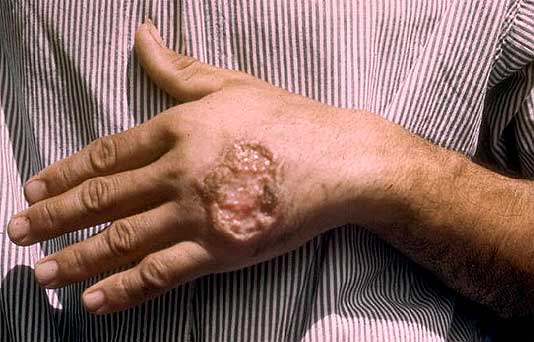Texas doctors have identified nine cases of the skin disease leishmaniasis in patients who have not traveled to any area that is known to have the disease.
The infectious disease skin disease, known as Baghdad boil, is common in the Middle East, South America, and Mexico.

Leishmaniasis sore on the back of a hand.
The infection causes large sores that look like boils and usually last six to 12 months. The disease is caused by a single-celled parasite called Leishmania, and special cultures must be done to confirm the diagnosis. The skins sores of leishmaniasis erupt weeks to months after the person affected is bitten by sand flies. Other consequences, which can become manifest anywhere from a few months to years after infection, include fever, damage to the spleen and liver, and anaemia.
The North Texas appears to be Leishmania mexicana — a less dangerous than other forms of the parasite.
Doctors suspect human infection begins when a sand fly bites a rodent called the burrowing wood rat, which carries the parasite. When the sand fly later bites a person, leishmaniasis sores may develop.
Leishmaniasis is present in Iraq and was contracted by a number of the troops involved in the 2003 invasion of that country and the subsequent occupation. The soldiers nicknamed the disease the Baghdad boil. It has been reported by Agence France-Presse that more than 650 U.S. soldiers may have experienced the disease between the start of the invasion in March 2003 and late 2004.
In fact, U.S. troops have experienced leishmaniasis cases in the Middle East already previously to the 2003 invasion, during the time of the previous Gulf conflict, when a large number of soldiers were stationed in Saudi Arabia. Of the 32 cases that were recorded by the U.S. military for that period (1990-1991), 20 were cutaneous, and 12 were the visceral type (a severe form in which parasites migrate to vital organs).
Leishmaniasis is one of the famous causes of a markedly enlarged spleen, which may become larger even than the liver. There are four main forms of leishmaniasis:
Visceral leishmaniasis – the most serious form and potentially fatal if untreated.
Cutaneous leishmaniasis – the most common form which causes a sore at the bite site, which heal in a few months to a year, leaving an unpleasant looking scar. This form can progress to any of the other three forms.
Diffuse cutaneous leishmaniasis – this form produces widespread skin lesions which resemble leprosy and is particularly difficult to treat.
Mucocutaneous leishmaniasis – commences with skin ulcers which spread causing tissue damage to (particularly) nose and mouth
More info:
Doctor without borders information on leishmaniasis …
